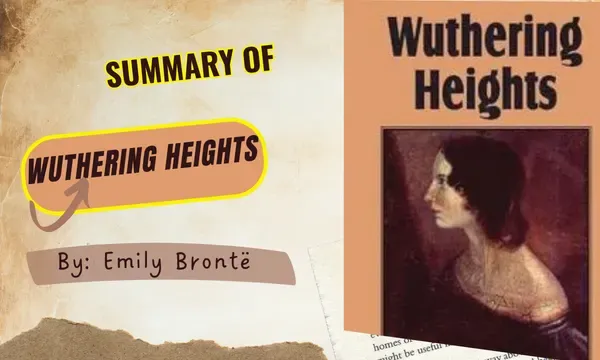Wuthering Heights explores themes of love, revenge, social class, and the destructive nature of unchecked passion.
 |
| Summary of Wuthering Heights by Emily Brontë |
The general idea of the book Wuthering Heights
- Love and obsession can have destructive consequences.
- Social class and societal norms constrain and shape individuals' lives.
- The novel presents a dark and complex portrayal of human nature.
Wuthering Heights book chapters
- 1. Lockwood's Arrival
The story begins with Mr. Lockwood renting Thrushcross Grange and encountering the enigmatic Heathcliff and the eerie Wuthering Heights.
- 2. Nelly's Narrative
Lockwood hears the history of the Earnshaw and Linton families from the housekeeper, Nelly, unfolding the tale of Heathcliff's tragic upbringing.
- 3. Heathcliff's Vengeance
Heathcliff's relentless quest for revenge on those who wronged him becomes the central focus of the novel.
- 4. Catherine's Ghost
The ghostly presence of Catherine Earnshaw continues to haunt the living, representing the enduring power of love and obsession.
- 5. The Next Generation
The story shifts to the next generation, highlighting the destructive impact of Heathcliff's revenge on the younger characters.
Wuthering Heights book conclusions
- Love and hatred are intertwined in a destructive dance throughout the novel.
- The societal norms and class divisions of 19th-century England deeply influence the characters' actions and destinies.
- "Wuthering Heights" offers a grim and unconventional exploration of human relationships and emotions.
About the author of Wuthering Heights
Emily Brontë, born in 1818, was an English novelist and poet. She lived in a parsonage on the Yorkshire moors, an environment that greatly influenced her writing. Brontë's personal experiences and vivid imagination contributed to the creation of this dark and passionate novel.
Wuthering Heights book relative to other books
"Wuthering Heights" is often compared to other classic novels like "Pride and Prejudice" by Jane Austen and "Jane Eyre" by Charlotte Brontë (Emily's sister). While these novels also delve into love and societal constraints, "Wuthering Heights" stands out for its intense and brooding exploration of destructive relationships.
Wuthering Heights book audience
The novel appeals to readers interested in classic literature, gothic fiction, and psychological dramas. Its complex characters and dark themes make it suitable for those who appreciate intricate storytelling.
Reception or Critical Response to the Book
Upon its publication in 1847, "Wuthering Heights" received mixed reviews due to its unconventional narrative and characters. However, it has since gained recognition as a literary masterpiece and is celebrated for its psychological depth and unconventional structure.
Wuthering Heights book publication date
The novel was first published by Thomas Cautley Newby in 1847.
Recommendations for other books
- "Jane Eyre" by Charlotte Brontë: Like "Wuthering Heights," this novel explores themes of love, societal constraints, and complex characters.
- "Frankenstein" by Mary Shelley: This gothic classic also delves into themes of obsession and the consequences of unchecked ambition.
In a sentence: "Wuthering Heights" by Emily Brontë is a dark and passionate novel that explores the destructive power of love and obsession in the context of societal norms and class divisions in 19th-century England.
At the end of our article, we would like to tell you that this wonderful novel enjoys the spirit of excitement and exploration. Here in our novel it includes exciting and strange events that make the reader not tire of reading this book, and that after reading our summary, he will head quickly to check out the events of the novel and delve deeper into them.
Readers are part of human life, so you should take care of them and walk behind useful books when you need them in life, or interesting books and novels in your spare time, because readers raise the status of its owner and enhance his status in society.
